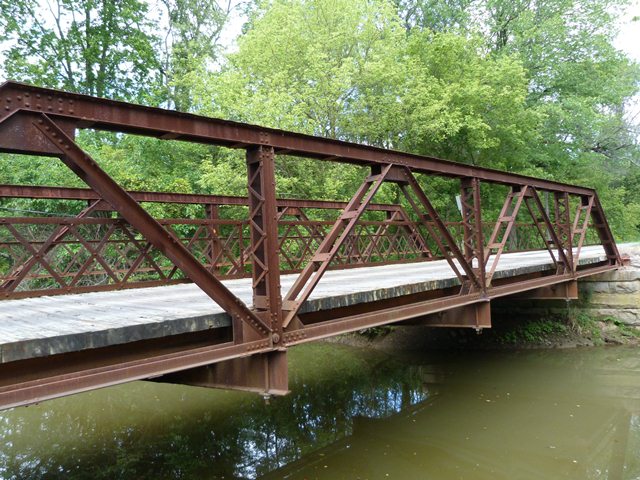We Recommend:
Bach Steel - Experts at historic truss bridge restoration.
Cardington Denmark Martel Road Bridge North

Primary Photographer(s): Nathan Holth
Bridge Documented: August 12, 2012
Rural: Morrow County, Ohio: United States
1910 By Builder/Contractor: York Bridge Company of York, Pennsylvania
2000
60.0 Feet (18.3 Meters)
62.0 Feet (18.9 Meters)
15.4 Feet (4.69 Meters)
1 Main Span(s)
5930448

View Information About HSR Ratings
Bridge Documentation
View Archived National Bridge Inventory Report - Has Additional Details and Evaluation
This bridge is in general a rivet-connected Warren pony truss bridge. However it is extremely rare because, unlike nearly all rivet-connected truss bridges, the floorbeams are not riveted to the gusset plates. Instead, a pin is also present at the gusset plates, and this pin holds a u-bolt hanger that in turn holds the floorbeams. The use of u-bolt hung floorbeams was common with pin-connected truss bridges, where the pin was already present for the truss members and was also used for the floorbeam-holding u-bolt. However, with rivet-connected truss bridges, the floorbeams typically were simply riveted directly to the same gusset plate that held the truss members together. This combination of rivet-connected trusses with u-bolt hangers is extremely unusual. The only place this detail occurs with regularity is on a railroad line, originally a Baltimore and Ohio Line. Examples of these overpass bridges, apparently a design of the railroad, occur in both Ohio and Indiana. A good example is here. However, the York Bridge Company, which built this bridge in Morrow County, also appears to have constructed an unknown number of rivet-connected pony truss bridges with u-bolt hung floor beams. Another example was found in Maryland here. Although the exact details of the pin are different, since the pin in the Maryland example does not extend through the gusset plate like this Ohio, the two bridges both have u-bolt hangers.
Information and Findings From Ohio's Historic Bridge InventorySetting/Context The bridge carries a 1 lane, rural road over a stream in a sparsely developed, rural setting. The road appears to be have a higher volume of traffic than many other rural roads. Physical Description The 1 span, 72'-long, rivet-connected Warren with verticals pony truss bridge is supported on stone abutments that may well predate the superstructure. While the truss lines are traditionally composed, the floorbeams are suspended with U-shaped suspenders rather than being framed into the lower panel point gusset plate. The suspenders are a 2000 in kind replacement. The plank deck is 15'-5" wide. Integrity Some holed section in lower chord battens. Summary of Significance The 1910 York Bridge Company riveted Warren with verticals pony truss bridge is historically and technologically significant because of the rare, transitional detail of pin connected floorbeams. It is one of
eight examples in the state with the detail but the only one that is not railroad related. Any connection between this bridge and the B&O Railroad that placed the other bridges is not known at this writing. The Morrow County bridge
is the only one documented to a fabricator. This is a rarely seen feature on otherwise riveted bridges. The connection is by means of a single suspender/hanger over a traditional pin, a detail that recalls earlier means of field
connections. This suggests that the bridge design is transitional and that using the simple pinned connection expedited erection. Whatever informed the decision, the detail is uncommon and reflects experimental thinking the Warren
pony truss bridge design. The detail is also seen on a series of 1904-07 B&O RR mainline overpasses in Ashland, Medina, Trumbull, and Portage counties. Justification The bridge has a rare construction detail that appears to be transitional from pinned to riveted field connections. The same floorbeam connection detail is used on a series of 7 B&O main line overpasses, but this example is the only one that is not railroad related. Its fabricator is documented. Bridge Considered Historic By Survey: Yes, High Significance |
![]()
Photo Galleries and Videos: Cardington Denmark Martel Road Bridge North
Bridge Photo-Documentation
Original / Full Size PhotosA collection of overview and detail photos. This gallery offers photos in the highest available resolution and file size in a touch-friendly popup viewer.
Alternatively, Browse Without Using Viewer
![]()
Bridge Photo-Documentation
Mobile Optimized PhotosA collection of overview and detail photos. This gallery features data-friendly, fast-loading photos in a touch-friendly popup viewer.
Alternatively, Browse Without Using Viewer
![]()
Northbound Crossing
Full Motion VideoStreaming video of the bridge. Also includes a higher quality downloadable video for greater clarity or offline viewing.
![]()
Maps and Links: Cardington Denmark Martel Road Bridge North
Coordinates (Latitude, Longitude):
Search For Additional Bridge Listings:
Bridgehunter.com: View listed bridges within 0.5 miles (0.8 kilometers) of this bridge.
Bridgehunter.com: View listed bridges within 10 miles (16 kilometers) of this bridge.
Additional Maps:
Google Streetview (If Available)
GeoHack (Additional Links and Coordinates)
Apple Maps (Via DuckDuckGo Search)
Apple Maps (Apple devices only)
Android: Open Location In Your Map or GPS App
Flickr Gallery (Find Nearby Photos)
Wikimedia Commons (Find Nearby Photos)
Directions Via Sygic For Android
Directions Via Sygic For iOS and Android Dolphin Browser
USGS National Map (United States Only)
Historical USGS Topo Maps (United States Only)
Historic Aerials (United States Only)
CalTopo Maps (United States Only)


